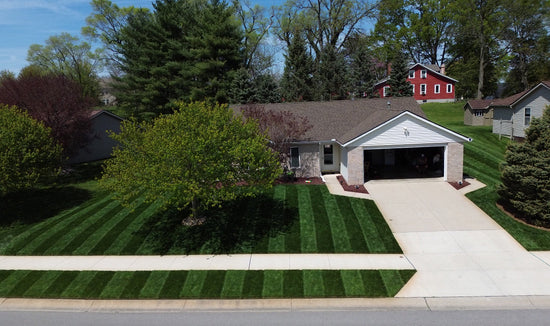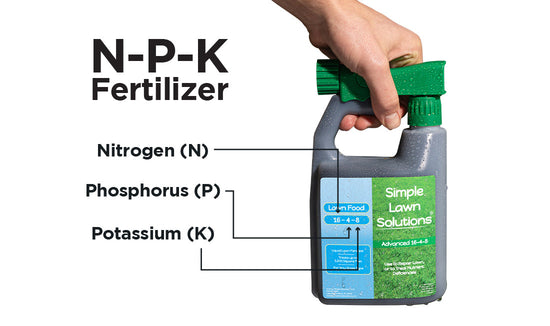Brown grass can often be revived, but its recovery depends on several factors, including the cause of browning, the type of grass, and the overall condition of the lawn. First, we must identify what is causing the turfgrass lawn to turn brown. Here’s a detailed look at whether brown grass can come back to life and what steps you can take to help it recover.

To effectively revive brown grass, it’s crucial to determine the underlying cause. Here are the primary factors that can lead to browning:
1. Drought Stress
Drought stress occurs when the grass turns brown because it does not receive enough water. This is common in hot, dry weather in certain regions. If the grass is dormant (not dead), it can recover once it gets adequate water. Dormant grass is still alive and will green up when conditions improve. Understanding the environmental, biological, and management factors that cause drought stress on lawns can help mitigate their impact and keep your lawn healthy even during dry conditions.

Key Contributors to Drought Stress on a Lawn:
- Insufficient Rainfall: Extended periods of low or no rainfall lead to soil moisture depletion, stressing the lawn as the grass struggles to find enough water, resulting in wilting, browning, and potentially dormancy.
- Watering Practices: Water the lawn deeply and infrequently by supplying it with 1-2 inches weekly. To reduce evaporation, avoid watering during the hottest part of the day. Watering in the early morning or late evening is ideal when rainfall has not occurred for over a week.
- High Temperatures: Hot weather increases evaporation and transpiration rates, causing soil and grass to lose moisture quickly. High temperatures can impair the grass's ability to photosynthesize, especially in cool-season grasses, reducing energy production for growth and repair. This makes the grass more susceptible to other stresses.
- Physical Damage: Direct and intense sunlight and high temperatures can cause grass blades to overheat and scorch. Grass blades may develop brown or bleached tips and edges, indicating cellular damage and dehydration.
- Low Humidity: Dry air conditions exacerbate water loss from the soil and grass blades, leading to dehydration and stress.
- Wind: Strong winds increase evaporation and remove moisture from the grass and soil surface, rapidly drying the lawn, especially in open or exposed areas.
- Soil Type: Sandy soils drain water quickly and have low water-holding capacity, while clay soils can become compact and hard. Sandy soils require more frequent watering, while clay soils can become less porous, making it harder for water to reach the grass roots.

2. Heat Stress
High temperatures can cause grass to turn brown, especially if combined with drought. Like drought stress, heat-stressed grass can recover if it's alive and receives proper care. Provide adequate water and consider applying a light topdressing of specific-sized sand or topsoil to protect the roots from heat. High air temperatures and prolonged exposure to temperatures above 85°F (29°C) can cause heat stress in many types of turfgrass.
3. Overwatering or Poor Drainage
Overwatering or poor drainage can cause excess water to remain on the surface and internally, suffocating grass roots and leading to browning. Grass may recover if drainage is improved and watering is reduced. Reduce watering frequency to improve soil drainage and aerate the lawn if necessary to improve airflow to the roots.
4. Soil Compaction
Soil compaction restricts root growth and water penetration, causing browning. If soil compaction is relieved, grass can recover. Aerate the lawn to allow water and nutrients to reach the roots.
5. Nutrient Deficiency
A lack of essential nutrients like nitrogen can cause the grass to turn yellow or brown. Grass usually recovers once nutrients are replenished. Apply a balanced fertilizer to provide the necessary nutrients.
6. Diseases or Pests
Fungal diseases, insects, or grubs can cause patches of grass to turn brown. Recovery depends on the severity and timely treatment of the problem. Identify and treat the specific disease or pest. Use appropriate fungicides or pesticides as needed.
7. Scalping (Mowing Too Low)
Cutting grass too short can stress it and cause browning. The grass may recover if proper mowing height is restored. Raise the mowing height to avoid cutting too many grass blades at once. Aim to remove no more than one-third of the grass height per mow.
8. Chemical Damage
If misapplied, herbicides, fertilizers, or other chemicals can burn grass. Depending on the extent of the damage, grass may recover with time and proper care. Flush the area with water to dilute chemicals and avoid using products in high heat or windy conditions.
9. Pet Urine
Urine contains nitrogen that can burn grass, causing brown spots. Grass often recovers if the affected area is treated and watered well. Train pets to use a designated area or water the spot immediately after the pet urinates to dilute the nitrogen concentration.
Lawn Maintenance Tips for Preventing Brown Grass

Proper lawn maintenance can prevent brown grass and promote a healthy, green lawn. Here are some essential tips:
Watering Practices
- Deep and Infrequent Watering: Provide 1-2 inches of water weekly, applied deeply and infrequently to encourage deep root growth.
- Optimal Watering Times: Water in the early morning or late evening to reduce evaporation and ensure the grass absorbs maximum moisture.
Mowing Practices
- Mowing Height: Avoid cutting grass too short. Taller grass shades the soil, retains moisture better, and reduces stress.
- Sharp Mower Blades: Use sharp mower blades to prevent tearing the grass, which can cause additional stress and water loss.
Soil Management
- Aeration: Aerate the lawn to relieve soil compaction, improve water infiltration, and promote healthy root growth.
- Soil Testing: Conduct soil tests to determine nutrient levels and adjust fertilization practices accordingly.
Fertilization Practices
- Balanced Fertilization: Apply a balanced fertilizer to ensure the grass receives the necessary nutrients without over-fertilizing, which can increase water demand.
- Seasonal Fertilization: Adjust fertilization schedules based on the grass type and seasonal growth patterns.
Pest and Disease Management
- Regular Monitoring: Inspect the lawn regularly for signs of pests and diseases and treat problems promptly to prevent significant damage.
- Integrated Pest Management: Use a combination of cultural, biological, and chemical controls to manage pests and diseases effectively.

Steps to Revive Brown Grass
Once you have identified the cause of brown grass, follow these steps to revive your lawn:
- Identify the Cause: Determine why the grass is brown by looking for patterns (e.g., brown spots from pet urine, uniform browning from drought).
- Adjust Watering: Ensure the lawn gets the right amount of water. Deep and infrequent watering is generally better than frequent shallow watering.
- Aerate the Lawn: If soil compaction is an issue, aerate to allow better water, nutrient, and air penetration into the root zone.
- Fertilize Appropriately: Apply a balanced fertilizer if a nutrient deficiency is suspected. Follow the recommended application rates.
- Mow Correctly: Keep your mower blades sharp and mow at the recommended height for your grass type.
- Treat Pests or Diseases: If pests or diseases are causing the problem, use appropriate treatments.
- Improve Soil Health: Adding a thin layer of compost or mulch can improve soil health and moisture retention.
- Overseed or Lay Sod: For severely damaged areas, overseeding or laying sod may be necessary to restore the lawn.
By following these guidelines, you can help your brown grass recover and maintain a healthy, green lawn.










1 comment
Very informative. It’s been a while since it’s rained enough here in Ohio. The weather has been warm to hot, also. I’m guessing now is not the time to fertilize so I will I will just water. There goes my water bill! LOL